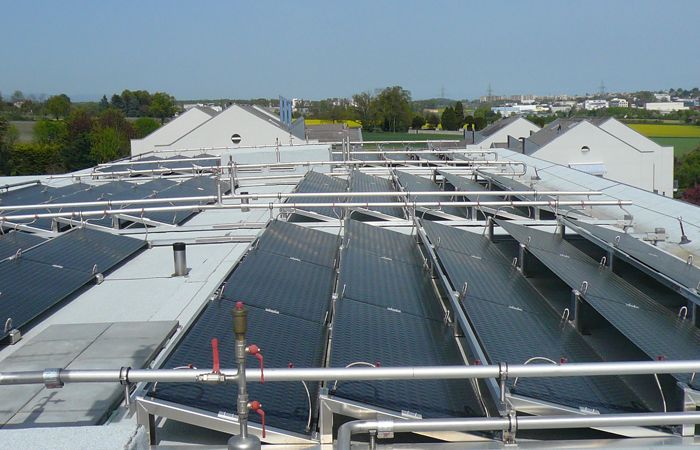
Image Source
This is a follow-up article in the Renewable Energy Series, earlier articles in the series include:
- Renewable Energy Technology Applications - Introduction
- Renewable Energy Technology - Solar Ventilation Air Pre-Heating
In most cases it’s not possible to meet 100% of hot water needs using solar, but typically 2/3 to ¾ of the needs can be met with a properly sized and well maintained solar water heating system.
It involves three component parts:
- Solar collectors: absorb heat from the sun and transfer heat to the water.
- Thermal Storage: thermal storage component stores water for use as needed.
- System Controls: Controls turn on/off a pump in response to the elevation of collector temperature above the temperature of the water to be heated.
So where are some of the areas where solar water heating is applicable:
- Where the water heating load is constant throughout the week.
- Where the water heating load is constant throughout the year.
- Where a sunny climate is prevalent.
- Where the cost of fuel to heat the water is relatively high.
- Where tax credits/rebates are available.

Basic types of solar water heaters/collectors are:
1. Low-Temperature unglazed collectors.
Consists of a black coloured matting or tubes made from plastic-based material through which the water circulates.
These panels can heat large volumes of water by a small temperature rise during warm sunny conditions, very ideal for swimming pools.
Operation
Source
| • Most Efficient at low temperatures. | • Inefficient at high temperatures as it is not insulated. |
| • Low cost. |

2. Glazed flat plate collectors.
Consists of an insulated, weather tight housing or box, a clear glass or plastic cover glazing, a black absorber plate, and a system of passages for the heat transfer to pass through the collector.
With a cover glass and insulation, glazed flat plate collectors are able to provide heat at higher temperatures than unglazed collectors.
Operation
Source
| • Cost is moderate. | • Inefficient at high temperatures or where solar radiation is low |
| • Efficient at moderate temperatures. |

3. Evacuated tube collectors.
Comprised of an array of single or twin wall glass tubes with a vacuum that provides excellent insulation against heat loss.
Design is similar to that of a thermos bottle where radiation can pass through the vacuum but there is no air to convert or conduct heat out so heat loss is minimized.
Suitable for high temperature applications due to:
- The tube design increases the surface area for absorption of the sun’s radiation from different angles (direct and diffuse radiation).
- The vacuum significantly reduces heat loss to the environment.
Operation
Source
| • Efficient at high temperatures and ares with low solar radiation levels | • Expensive |
| * Not efficient where temperatures are low |

4. Parabolic troughs.
Use curved mirrors to focus sunlight on an evacuated tube receiver that runs along the reflectors focal lines.
They use only direct radiation and are most effective where there are very clear skies.
Operation
Source
| • Most cost effective at high temperature and large scale applications | • Complicated for small projects |
| • Unsuitable for roof mount applications as they require very large spaces to install. |

The four solar water collector types can be classified into two systems:
- Passive Systems (No pumps)
a. Thermosyphon.
b. Integral collector storage. - Active Systems (Pumps and Controls)
c. Open loop (Direct and Drain Down).
d. Closed loop (Drain back and Antifreeze).
Image Source

References
Next Article: Concentrating Power Technologies. For More


If you're interested in STEM and like to create STEM-related content, feel free to use the #steemstem tag, for guidelines visit STEM Guidelines


Amazing to learn exactly how the solar heater works...I fee like this should be a staple in every home in Kenya!
I mean, we have sunlight throughout the year..except for those 2 to 3 cold months. But even then, the sun will still peek out once in a while.
Downvoting a post can decrease pending rewards and make it less visible. Common reasons:
Submit
We have an abundance of the sun's energy and we are not even making use of it.
Downvoting a post can decrease pending rewards and make it less visible. Common reasons:
Submit
You got a 4.71% upvote from @minnowvotes courtesy of @cmbugua!
Downvoting a post can decrease pending rewards and make it less visible. Common reasons:
Submit
Thank you @cmbugua for making a transfer to me for an upvote of 0.72% on this post! Half of your bid goes to @budgets which funds growth projects for Steem like our top 25 posts on Steem! The other half helps holders of Steem power earn about 60% APR on a delegation to me! For help, will you please visit https://jerrybanfield.com/contact/ because I check my discord server daily? To learn more about Steem, will you please use http://steem.guide/ because this URL forwards to my most recently updated complete Steem tutorial?
Downvoting a post can decrease pending rewards and make it less visible. Common reasons:
Submit
This post has received a 0.99% upvote from thanks to: @cmbugua.
thanks to: @cmbugua.
For more information, click here!!!!
Send minimum 0.100 SBD to bid for votes.
The Minnowhelper team is still looking for investors (Minimum 10 SP), if you are interested in this, read the conditions of how to invest click here!!!
ROI Calculator for Investors click here!!!
Downvoting a post can decrease pending rewards and make it less visible. Common reasons:
Submit
We should make use of solar energy, its full potential has not been explored.
Downvoting a post can decrease pending rewards and make it less visible. Common reasons:
Submit
Renewable energy is the next big thing. Thanks for the the teachings.
Downvoting a post can decrease pending rewards and make it less visible. Common reasons:
Submit